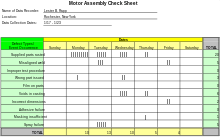Seven Basic Tools of Quality
The Seven Basic Tools of Quality is a designation given to a fixed set of graphical techniques identified as being most helpful in troubleshooting issues related to quality.[1] They are called basic because they are suitable for people with little formal training in statistics and because they can be used to solve the vast majority of quality-related issues.[2]
- Cause-and-effect diagram (also known as the "fishbone" or Ishikawa diagram)
- Check sheet
- Control chart
- Histogram
- Pareto chart
- Scatter diagram
- Stratification (alternately, flow chart or run chart)
The designation arose in postwar Japan, inspired by the seven famous weapons of Benkei.[6] It was possibly introduced by Kaoru Ishikawa who in turn was influenced by a series of lectures W. Edwards Deming had given to Japanese engineers and scientists in 1950.[7] At that time, companies that had set about training their workforces in statistical quality control found that the complexity of the subject intimidated the vast majority of their workers and scaled back training to focus primarily on simpler methods which suffice for most quality-related issues.[8]
The Seven Basic Tools stand in contrast to more advanced statistical methods such as survey sampling, acceptance sampling, statistical hypothesis testing, design of experiments, multivariate analysis, and various methods developed in the field of operations research.[9]
The Project Management Institute references the Seven Basic Tools in A Guide to the Project Management Body of Knowledge as an example of a set of general tools useful for planning or controlling project quality.[10]
Examples
 Cause-and-effect diagram
Cause-and-effect diagram Check sheet
Check sheet Control chart
Control chart Histogram
Histogram Pareto chart
Pareto chart Scatter diagram
Scatter diagram Flow chart
Flow chart Run chart
Run chart
See also
References
- ↑ Montgomery, Douglas (2005). Introduction to Statistical Quality Control. Hoboken, New Jersey: John Wiley & Sons, Inc. p. 148. ISBN 978-0-471-65631-9. OCLC 56729567.
- ↑ Ishikawa, Kaoru (1985), What Is Total Quality Control? The Japanese Way (1 ed.), Englewood Cliffs, New Jersey: Prentice-Hall, p. 198, ISBN 978-0-13-952433-2, OCLC 11467749,
From my past experience as much as ninetey-five percent of all problems within a company can be solved by means of these tools.
- ↑ Nancy R. Tague (2004). "Seven Basic Quality Tools". The Quality Toolbox. Milwaukee, Wisconsin: American Society for Quality. p. 15. Retrieved 2010-02-05.
- ↑ Ishikawa, Kaoru (1985), What Is Total Quality Control? The Japanese Way (1 ed.), Englewood Cliffs, New Jersey: Prentice-Hall, p. 198, ISBN 978-0-13-952433-2, OCLC 11467749,
Elementary Statistical Method (the so-called Seven Tools) 1. Pareto chart: The principle of vital few; trivial many 2. Cause and effect diagram (This is not precisely a statistical technique) 3. Stratification 4. Check sheet 5. Histogram. 6. Scatter diagram (analysis of correlation through determination of median; in some instances, use of binomial probability paper) 7. Graph and control chart (Shewhart control chart)
- ↑ Imai, Masaaki (1986), Kaizen (Ky'zen), the Key to Japan's Competitive Success (1 ed.), New York: Random House, pp. 239–240, ISBN 9780394551869, OCLC 13010323,
The seven statistical tools used for such analytical problem-solving are: 1. Pareto diagrams [...] 2. Cause-and-effect diagrams [...] 3. Histograms [...] 4. Control charts [...] 5. Scatter diagrams [...] 6. Graphs [...] 7. Checksheets.
- ↑ Ishikawa, Kaoru (1990), Introduction to Quality Control (1 ed.), Tokyo: 3A Corp, p. 98, ISBN 978-4-906224-61-6, OCLC 23372992,
They were named the Seven QC Tools after the famous seven weapons of the Japanese Kamakura-era warrior-priest Benkei which enabled Benkei to triumph in battle; so too, the Seven QC Tools, if used skillfully, will enable 95% of workplace problems to be solved. In other words, intermediate and advanced statistical tools are needed in about only 5% of cases.
- ↑ "The seven basic tools of quality". Improvement and Innovation.com. London. 2007-11-30. Retrieved 2013-05-18.
Ishikawa had a desire to 'democratise quality': that is to say, he wanted to make quality control comprehensible to all workers, and inspired by Deming’s lectures, he formalised the Seven Basic Tools of Quality Control.
- ↑ Ishikawa, Kaoru (1985), What Is Total Quality Control? The Japanese Way (1 ed.), Englewood Cliffs, New Jersey: Prentice-Hall, p. 18, ISBN 978-0-13-952433-2, OCLC 11467749,
It is true that statistical methods are effective, but we overemphasized their importance. As a result, people either feared or disliked quality control as something very difficult. We overeducated people by giving them sophisticated methods where, at that stage, simple methods would have sufficed.
- ↑ Ishikawa, Kaoru (1985), What Is Total Quality Control? The Japanese Way (1 ed.), Englewood Cliffs, New Jersey: Prentice-Hall, pp. 198–9, ISBN 978-0-13-952433-2, OCLC 11467749,
I divide statistical methods into the following three categories according to their level of difficulty. 1. Elementary Statistical Method (the so-called Seven Tools) [...] 2. Intermediate Statistical Method [...] 3. Advanced Statistical Method (using computers concurrently)
- ↑ A Guide to the Project Management Body of Knowledge. Newtown Square, PA: Project Management Institute. 2013. pp. 236–238. ISBN 978-1-935589-67-9.